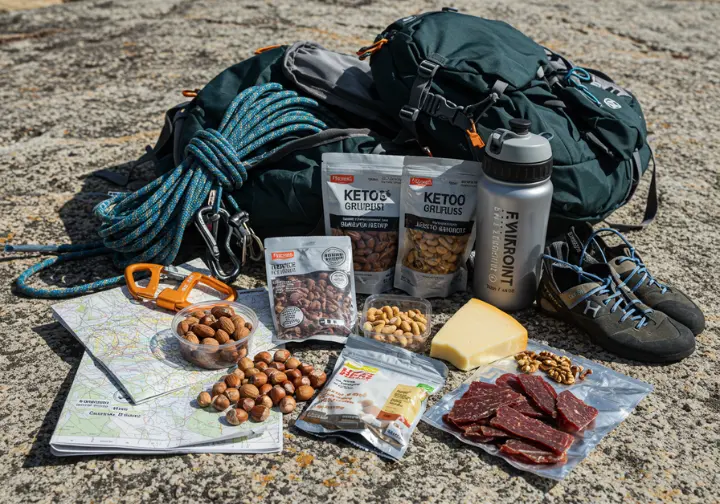In this article
The low-carbohydrate diet is a significant point of debate within the climbing community. In the relentless pursuit of an optimal power-to-weight ratio and specific fitness goals, climbers often scrutinize their diet. This has led to a central question: can a low-carb approach truly fuel the unique blend of power and endurance that climbing demands? Low-carbohydrate and ketogenic diets have surged in popularity in the broader athletic world, sparking both curiosity and controversy among climbers. This article offers an evidence-based look at how these diets affect the distinct energy systems used in climbing, helping you make informed nutritional decisions.
Foundational Concepts: Climbing Physiology and Low-Carb Diets

Before diving into the low-carb and exercise debate, it’s essential to understand the fundamentals of exercise physiology. We’ll explore the unique physical demands of our sport, define what low-carb and ketogenic diets entail, and detail the body’s core energy systems. A clear grasp of these concepts is necessary to evaluate how any diet truly impacts exercise performance on the wall.
The Physical Demands of Climbing
Muscular power is the ability to generate immense force in a short time, which is crucial for dynamic moves like dynos. This type of muscular activity primarily recruits fast-twitch (Type II) muscle fibers that contract forcefully but also fatigue quickly. In contrast, muscular endurance involves sustaining lower force levels over long periods, essential for long endurance exercise like multi-pitch climbing. This activity relies on slow-twitch (Type I) muscle fibers, which are highly fatigue-resistant but produce less peak force.
Most climbing disciplines are intermittent, blending bursts of high-intensity exercise with periods of rest or lower-intensity movement. This means climbers must be metabolically flexible, capable of using different energy pathways in rapid succession. Because the power-to-mass ratio is a critical determinant of performance, managing body weight is a key nutritional goal, and targeted strength training is essential for climbers.
Defining Low-Carb vs. Ketogenic Diets
A general “low-carbohydrate diet” (LCD) broadly limits carbohydrate-rich foods like grains, legumes, and refined carbs, with daily dietary carbohydrate intake often ranging from 20 to 57 grams. The primary goal is often weight loss, but it can also be used for managing certain health conditions. For a comprehensive definition of a low-carb diet, the Mayo Clinic provides an authoritative resource.
The Ketogenic Diet (KD) is a much stricter form of LCD, a very low carbohydrate diet characterized by a high fat intake (55-75% of calories), moderate protein, and extremely low carbohydrate consumption (typically under 50g/day). The main purpose is to induce ketosis, where the body, deprived of glucose, switches its primary fuel source to ketones. The International Society of Sports Nutrition specifies that nutritional ketosis involves serum ketone levels above 0.5 mM. This approach emphasizes a high fat intake, moderate protein.
Fueling the Ascent: Your Body’s Energy Systems
The body uses several energy systems to fuel a climb. For extremely short, maximal-effort anaerobic exercise lasting less than 10 seconds, the ATP-PC system provides immediate energy. It uses readily available ATP stored in the muscles but depletes almost instantly. For a difficult boulder problem lasting from 10 seconds to a few minutes, the body uses the Anaerobic Glycolysis System. This system breaks down glucose from stored carbohydrate (glycogen) to produce energy without oxygen, but its byproduct can contribute to fatigue.
For longer, lower-intensity exercise and recovery between intense efforts, the Aerobic System takes over. It uses oxygen to metabolize both carbohydrates and fats for a sustainable energy source. Diets low in carbohydrates lead to lower muscle glycogen stores. Glycogen is the stored form of glucose, and its depletion can compromise anaerobic metabolism, potentially hindering performance during high-intensity workouts.
The Great Performance Debate: Low-Carb Exercise for Climbers

Here we arrive at the central conflict: evaluating the theoretical benefits that attract climbers to a low-carb diet against the significant potential downsides. For high-intensity disciplines, the stakes are high. Understanding both sides of this debate, supported by exercise science, is key to making a well-informed decision about your own nutrition and how it impacts your climbing performance.
Potential Perks: Why Climbers Consider Keto
A primary driver for climbers considering a keto diet is improving the power-to-weight ratio. These diets are known for promoting fat loss, which helps climbers achieve a leaner build while preserving muscle if protein intake and resistance exercise are adequate. Another major appeal is achieving “fat adaptation,” where the body becomes efficient at burning its vast fat stores for fuel. This could theoretically provide nearly limitless energy for prolonged, lower-intensity endurance activities, making ultra-endurance athletes feel “bonk-proof.”
Many people also report better satiety and reduced cravings, as protein and fat are more filling than carbohydrates. This can simplify maintaining a caloric deficit for weight management goals. Finally, anecdotal reports from elite climbers like Dave MacLeod, who have shared positive experiences with carbohydrate-restricted diets, further fuel curiosity within the climbing community.
Potential Downsides and Performance Risks
The most significant risk of a low-carbohydrate diet for climbers is impaired high-intensity performance. Anaerobic efforts, like powerful boulder moves or sprinting through crux sequences, can be negatively affected due to reduced availability of muscle glycogen. This is one of the biggest Potential Downsides and Performance Risks to consider, as glycogen is the main fuel for the rapid carbohydrate oxidation required for such movements.
The transition period into ketosis is often accompanied by the “keto flu,” with symptoms like headache, fatigue, and muscle cramps. This challenging adaptation phase can last for several days to weeks and may deter many individuals from their regular exercise routine. The restrictive nature of a ketogenic diet can also lead to nutrient deficiencies if not carefully planned. There are also potential long-term health considerations that require more research, including unfavorable changes in blood lipids.
The Power vs. Endurance Verdict for Low Carb Exercise
For power-focused climbing like bouldering, a ketogenic diet is highly controversial. While some low carb studies suggest maximal strength might be maintained, the ability to produce explosive, repeatable power for high-performance exercise is likely to be impaired due to low carbohydrate stores. For endurance-focused climbing, such as long multi-pitch routes, the theoretical appeal is stronger due to enhanced fat oxidation and glycogen sparing. This could provide sustained, steady energy for all-day efforts.
However, a critical caveat exists: even long endurance sports have intense crux sections that demand anaerobic power. A fully fat-adapted climber may struggle to fuel these bursts, potentially compromising overall performance. The ideal state may be “metabolic flexibility”—the ability to efficiently use both fat and carbs as needed—rather than relying solely on one fuel source.
Voices from the Lab and the Crag: Expert Opinions

A balanced view requires hearing from both the lab and the crag. By examining perspectives from leading scientific researchers and anecdotal evidence from experienced climbers, we can build a more complete picture of the low-carbohydrate dieting landscape and what it means for dedicated athletes in our sport.
Proponents: The Research of Phinney & Volek
Drs. Stephen Phinney and Jeff Volek are prominent researchers who argue that with proper keto-adaptation, the body can effectively use fats and ketones to fuel even high-intensity exercise. They propose that achieving optimal adaptation for high-intensity performance may take several months, longer than the typical few weeks for endurance benefits. They suggest that many negative reports on low-carbohydrate nutrition stem from incomplete adaptation or incorrect diet implementation.
Their research indicates that keto-adapted athletes can experience enhanced fat oxidation, reduced inflammation, and faster recovery. They also assert that with a specific, targeted exercise program, power performance can be maintained or even augmented on a ketogenic diet, which Dr. Volek discusses in presentations on Physical Performance and Ketogenic Diets.
Critical Perspectives: The Work of Louise Burke
Professor Louise Burke, a highly respected sports nutrition scientist, offers a strong counterargument based on her extensive research with elite endurance athletes. A key finding from her work is that keto-adaptation often impairs “exercise economy” or exercise efficiency, meaning athletes must use more oxygen to perform at a given intensity. This can be detrimental to performance, and may come at the direct expense of elite performance.
Her research has shown that while athletes on a low carbohydrate high fat diet become excellent fat-burners, their ability to use carbohydrates effectively is simultaneously down-regulated. This down-regulated carbohydrate metabolism can hurt performance during crucial moments that require a burst of power, a key consideration for climbers at a crux. She also raises concerns about potential negative impacts on bone health.
The Official Stance: International Society of Sports Nutrition (ISSN)
In a 2021 position stand, the ISSN provides an evidence-based review of ketogenic diets for exercise. Their primary conclusion is that a ketogenic diet generally has neutral or, more often, detrimental effects on performance compared to a higher-carbohydrate diet, despite leading to high rates of fat oxidation. Regarding strength, the ISSN finds that a KD tends to have similar effects on maximal strength and resistance exercise gains as a high-carb diet, though a minority of studies show non-keto diets as superior.
The ISSN notes that all reviewed studies involving elite athletes showed a performance decrement from a ketogenic diet. A full review of the International society of sports nutrition position stand: ketogenic diets shows their overall position is cautious and generally negative regarding the use of these diets for performance enhancement in most sports.
A Practical Guide for the Curious Climber

For the curious climber ready to experiment, it’s time to shift from theory to action. It is possible to safely combine a low-carb diet and exercise, but it requires a plan. We’ll cover how to manage the transition, handle side effects, and develop effective fueling strategies for your workouts and climbing sessions to ensure a safe, sustainable approach.
The “Keto Flu” and Managing Electrolytes
One of the biggest hurdles when starting a ketogenic diet is managing the “keto flu,” with symptoms like headaches and fatigue. These symptoms are primarily caused by dehydration and an imbalance of key electrolytes. When carbohydrate intake is restricted, insulin levels drop, signaling the kidneys to excrete more sodium. This loss disrupts the balance of other crucial electrolytes like potassium and magnesium.
To mitigate the keto flu, it is critical to consciously increase the intake of these electrolytes. This means liberally salting food (4-6g of sodium per day) and consuming keto-friendly foods rich in potassium, such as avocados and spinach, and magnesium, found in nuts and leafy greens. A good low carb breakfast can help start the day right.
Fueling Your Climb on a Low-Carb Diet
Pre-climb nutrition should focus on fats and moderate protein, like eggs with avocado, consumed 1-4 hours before a session or workout. Some climbers use a Targeted Ketogenic Diet (TKD) approach, consuming a small amount (10-25g) of fast-acting carbs 30-60 minutes before an intense workout to fuel high-intensity effort without disrupting overall ketosis. During long climbing sessions, the focus should be on hydration and electrolyte replacement with low-carbohydrate meals or snacks like nuts, cheese, and olives.
Post-climb recovery hinges on muscle repair. Consuming 20-25 grams of high-quality protein is crucial for muscle protein synthesis, paired with healthy fats to restore energy. Proper timing your pre- and post-workout nutrition is key for any athlete.
Carb Cycling: A More Flexible Alternative?
For climbers wary of a full ketogenic diet, a carb-cycle strategy offers a more flexible alternative. This approach involves planned alternation between high-carbohydrate and low-carbohydrate days, rather than chronic carb restriction. The strategy is to align high-carb days with intense training sessions to maximize glycogen stores and fuel high-intensity exercise benefits. Low-carb days are then scheduled for rest or lighter training to promote insulin sensitivity and the body’s ability to burn fat.
A primary goal of carb cycling is to enhance metabolic flexibility, which is the body’s ability to efficiently switch between burning carbs and fats for fuel. This may allow a climber to reap some of the benefits of fat adaptation without sacrificing the top-end power needed for hard moves, potentially offering a sustainable middle ground.
Conclusion: Weighing the Evidence for Your Climbing Journey
The decision to adopt a low-carb or ketogenic diet for climbing is highly individual, with no one-size-fits-all answer. It requires balancing the potential for improved body composition against significant risks to high-intensity exercise performance. A substantial body of scientific evidence suggests that for most athletes, ketogenic diets are neutral or detrimental to the anaerobic power crucial for bouldering and sport climbing cruxes.
The outcome of such a dietary change depends heavily on genetics, the discipline of the climber, the duration of adaptation, and the specifics of the training regimen. What works for one elite climber may not work for another. Always proceed with caution, monitor your body’s response, and consult with healthcare and exercise professionals before making a significant dietary change. Flexible approaches like carb cycling may offer a more sustainable path for many.
Frequently Asked Questions about Low-Carb Diets and Exercise for Climbers
How long does it take to become “keto-adapted” for climbing? +
Can I build or maintain muscle on a ketogenic diet as a climber? +
What are some good keto-friendly snack ideas for a day at the crag? +
Is a ketogenic diet safe for young or adolescent climbers? +
We are a participant in the Amazon Services LLC Associates Program, an affiliate advertising program designed to provide a means for sites to earn advertising fees by advertising and linking to Amazon.com. As an Amazon Associate I earn from qualifying purchases. We also participate in other affiliate programs. The information provided on this website is provided for entertainment purposes only. We make no representations or warranties of any kind, expressed or implied, about the completeness, accuracy, adequacy, legality, usefulness, reliability, suitability, or availability of the information, or about anything else. Any reliance you place on the information is therefore strictly at your own risk. Additional terms are found in the terms of service.











